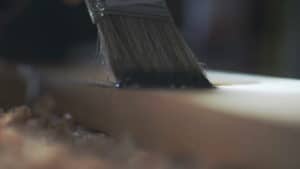DIY projects are a great way to save some money on professional renovations, freshen up your interiors and keep yourself occupied, especially now with the global pandemic forcing us to spend more time at home. If you have only just begun to discover the DIY world, you might be surprised by how many jobs you can do by yourself, even without any specific skills.
A paint job is an excellent example of a simple change that can turn the whole design around. In this article, we will focus mainly on wood painting. Whether you want to renovate some old furniture, create a piece of art or get wild with the color of your kitchen cabinets, you will surely be impressed by the effect – as long as you do the job right.
Below you can read about common mistakes that are likely to be made during a painting project. Hopefully, this article will help you avoid them.

Rushing
Am I truly enthusiastic about my plan? How long does a primer take to dry? Do I have enough time for this? How long does the paint dry?
These are only a few of the many questions you should ask yourself and find answers to before you get to work. Rushing into a renovation project is one of the most common mistakes – people don’t think everything through too carefully, or they get so excited that they start painting without the proper preparations. Unfortunately, this often leads to further problems.
So, make sure you know what you want and have all the necessary information and equipment to finish the job.
No Cleaning before the Job
Use a special wood cleaner or wax remover to clean the surface you want to paint. It may turn out that your old cabinets aren’t really damaged or faded – they might only need a thorough cleaning. And if it’s more about the looks than the condition, you will still save yourself some time, as dirt can alter your chosen color, even the fresh one, or cause peeling paint.
Not Removing the Finish or Removing It Incorrectly
Removing the old finish is not always necessary but certainly recommended, especially when working with old wooden furniture. Once you decide you want to remove it, you need to make sure you get rid of all the finish; otherwise, the surface would be uneven, which will show when you apply the new paint.
With the help of chemical strippers ( you can find them in virtually all improvement stores, both brick-and-mortar and online), all you need to do is use it on the whole surface and wait. Again, don’t rush – if you don’t give it enough time, you will end up scraping. Be sure to stick to the producer’s recommendations, because if you wait too long, the paint will re-harden.
Sanding Incorrectly
If you want a smooth surface to apply the paint evenly, you need to focus on the sanding part especially. Many beginning DIYers don’t realize that it actually matters in which direction you are sanding – you should always do it with the grain instead of against it. If you go otherwise, you will quickly see it once you get to painting. Only by going with the grain can you achieve a truly smooth surface.
The most important thing is to stay reasonable. You don’t want to sand too much and damage the wood, but ensure you get rid of all the flaws.
Not Using Primer
Using a primer is the essential finishing touch that allows the paint to stick better to the surface – it protects the color, thus helping your project look better for longer.
Too Much or Too Little Paint
Too little paint will make the whole surface look faded, see-through, and unfinished, while too many coats will simply look wrong and cheap. Apply the paint color coat by coat, layer by layer, paying attention to whether you do it evenly. Cover the whole surface and if you need a break, ensure that it’s in-between coats. Each layer of paint needs to dry off before you apply another.
To make it smoother, remember about rubbing out the finish once you’re done.
Final Thoughts
DIY projects can bring many benefits to your household – you will transform your interiors and have a little fun in the process. Whether it’s a bigger renovation plan, some furniture painting, or creating art, you are sure to get a lot of satisfaction from your work.
However, it is essential to do it right, as you probably want the effects to look attractive. By bearing some of the most common mistakes, you are less likely to repeat them. Of course, our list is not by any means conclusive: you also need to pay attention to your paintbrush or ensure you’re not using the wrong paint and primer (among other things).
The rule of thumb is – always be prepared. Don’t start a project if you haven’t thought the whole process out carefully. You will thank yourself later.

Recent Comments